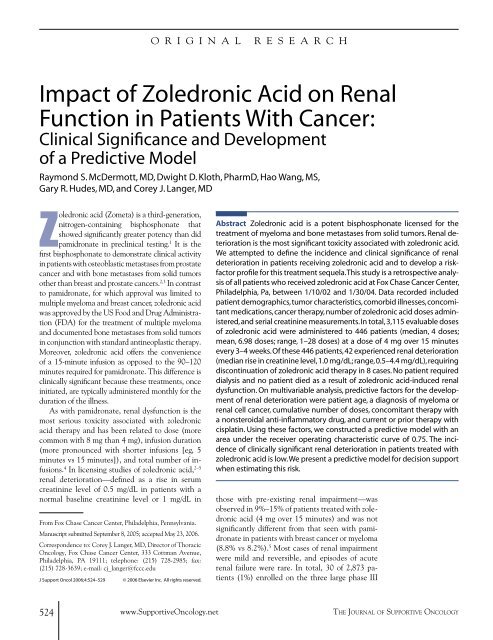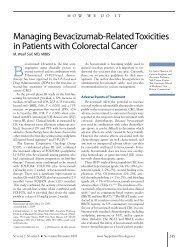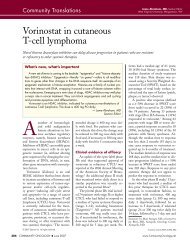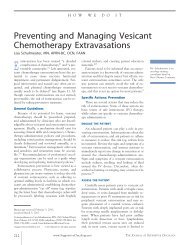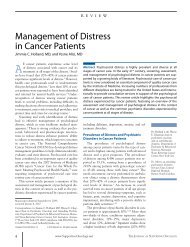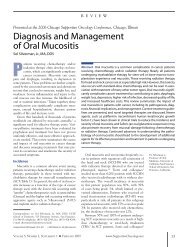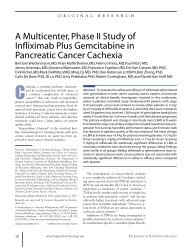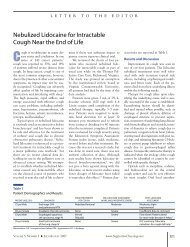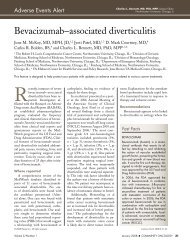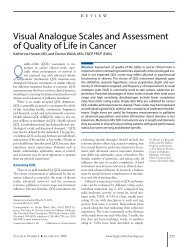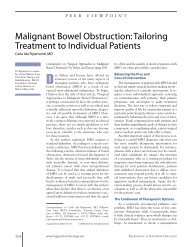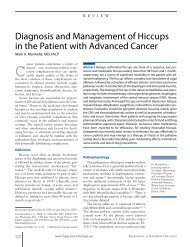Impact of Zoledronic Acid on Renal Function in Patients With Cancer ...
Impact of Zoledronic Acid on Renal Function in Patients With Cancer ...
Impact of Zoledronic Acid on Renal Function in Patients With Cancer ...
Create successful ePaper yourself
Turn your PDF publications into a flip-book with our unique Google optimized e-Paper software.
O R I G I N A L R E S E A R C H<br />
<str<strong>on</strong>g>Impact</str<strong>on</strong>g> <str<strong>on</strong>g>of</str<strong>on</strong>g> <str<strong>on</strong>g>Zoledr<strong>on</strong>ic</str<strong>on</strong>g> <str<strong>on</strong>g>Acid</str<strong>on</strong>g> <strong>on</strong> <strong>Renal</strong><br />
Functi<strong>on</strong> <strong>in</strong> <strong>Patients</strong> <strong>With</strong> <strong>Cancer</strong>:<br />
Cl<strong>in</strong>ical Significance and Development<br />
<str<strong>on</strong>g>of</str<strong>on</strong>g> a Predictive Model<br />
Raym<strong>on</strong>d S. McDermott, MD, Dwight D. Kloth, PharmD, Hao Wang, MS,<br />
Gary R. Hudes, MD, and Corey J. Langer, MD<br />
Z<br />
oledr<strong>on</strong>ic acid (Zometa) is a third-generati<strong>on</strong>,<br />
nitrogen-c<strong>on</strong>ta<strong>in</strong><strong>in</strong>g bisphosph<strong>on</strong>ate that<br />
showed significantly greater potency than did<br />
pamidr<strong>on</strong>ate <strong>in</strong> precl<strong>in</strong>ical test<strong>in</strong>g. 1 It is the<br />
first bisphosph<strong>on</strong>ate to dem<strong>on</strong>strate cl<strong>in</strong>ical activity<br />
<strong>in</strong> patients with osteoblastic metastases from prostate<br />
cancer and with b<strong>on</strong>e metastases from solid tumors<br />
other than breast and prostate cancers. 2,3 In c<strong>on</strong>trast<br />
to pamidr<strong>on</strong>ate, for which approval was limited to<br />
multiple myeloma and breast cancer, zoledr<strong>on</strong>ic acid<br />
was approved by the US Food and Drug Adm<strong>in</strong>istrati<strong>on</strong><br />
(FDA) for the treatment <str<strong>on</strong>g>of</str<strong>on</strong>g> multiple myeloma<br />
and documented b<strong>on</strong>e metastases from solid tumors<br />
<strong>in</strong> c<strong>on</strong>juncti<strong>on</strong> with standard ant<strong>in</strong>eoplastic therapy.<br />
Moreover, zoledr<strong>on</strong>ic acid <str<strong>on</strong>g>of</str<strong>on</strong>g>fers the c<strong>on</strong>venience<br />
<str<strong>on</strong>g>of</str<strong>on</strong>g> a 15-m<strong>in</strong>ute <strong>in</strong>fusi<strong>on</strong> as opposed to the 90–120<br />
m<strong>in</strong>utes required for pamidr<strong>on</strong>ate. This difference is<br />
cl<strong>in</strong>ically significant because these treatments, <strong>on</strong>ce<br />
<strong>in</strong>itiated, are typically adm<strong>in</strong>istered m<strong>on</strong>thly for the<br />
durati<strong>on</strong> <str<strong>on</strong>g>of</str<strong>on</strong>g> the illness.<br />
As with pamidr<strong>on</strong>ate, renal dysfuncti<strong>on</strong> is the<br />
most serious toxicity associated with zoledr<strong>on</strong>ic<br />
acid therapy and has been related to dose (more<br />
comm<strong>on</strong> with 8 mg than 4 mg), <strong>in</strong>fusi<strong>on</strong> durati<strong>on</strong><br />
(more pr<strong>on</strong>ounced with shorter <strong>in</strong>fusi<strong>on</strong>s [eg, 5<br />
m<strong>in</strong>utes vs 15 m<strong>in</strong>utes]), and total number <str<strong>on</strong>g>of</str<strong>on</strong>g> <strong>in</strong>fusi<strong>on</strong>s.<br />
4 In licens<strong>in</strong>g studies <str<strong>on</strong>g>of</str<strong>on</strong>g> zoledr<strong>on</strong>ic acid, 2–5<br />
renal deteriorati<strong>on</strong>—def<strong>in</strong>ed as a rise <strong>in</strong> serum<br />
creat<strong>in</strong><strong>in</strong>e level <str<strong>on</strong>g>of</str<strong>on</strong>g> 0.5 mg/dL <strong>in</strong> patients with a<br />
normal basel<strong>in</strong>e creat<strong>in</strong><strong>in</strong>e level or 1 mg/dL <strong>in</strong><br />
From Fox Chase <strong>Cancer</strong> Center, Philadelphia, Pennsylvania.<br />
Manuscript submitted September 8, 2005; accepted May 23, 2006.<br />
Corresp<strong>on</strong>dence to: Corey J. Langer, MD, Director <str<strong>on</strong>g>of</str<strong>on</strong>g> Thoracic<br />
Oncology, Fox Chase <strong>Cancer</strong> Center, 333 Cottman Avenue,<br />
Philadelphia, PA 19111; teleph<strong>on</strong>e: (215) 728-2985; fax:<br />
(215) 728-3639; e-mail: cj_langer@fccc.edu<br />
J Support Oncol 2006;4:524–529<br />
© 2006 Elsevier Inc. All rights reserved.<br />
Abstract <str<strong>on</strong>g>Zoledr<strong>on</strong>ic</str<strong>on</strong>g> acid is a potent bisphosph<strong>on</strong>ate licensed for the<br />
treatment <str<strong>on</strong>g>of</str<strong>on</strong>g> myeloma and b<strong>on</strong>e metastases from solid tumors. <strong>Renal</strong> deteriorati<strong>on</strong><br />
is the most significant toxicity associated with zoledr<strong>on</strong>ic acid.<br />
We attempted to def<strong>in</strong>e the <strong>in</strong>cidence and cl<strong>in</strong>ical significance <str<strong>on</strong>g>of</str<strong>on</strong>g> renal<br />
deteriorati<strong>on</strong> <strong>in</strong> patients receiv<strong>in</strong>g zoledr<strong>on</strong>ic acid and to develop a riskfactor<br />
pr<str<strong>on</strong>g>of</str<strong>on</strong>g>ile for this treatment sequela. This study is a retrospective analysis<br />
<str<strong>on</strong>g>of</str<strong>on</strong>g> all patients who received zoledr<strong>on</strong>ic acid at Fox Chase <strong>Cancer</strong> Center,<br />
Philadelphia, Pa, between 1/10/02 and 1/30/04. Data recorded <strong>in</strong>cluded<br />
patient demographics, tumor characteristics, comorbid illnesses, c<strong>on</strong>comitant<br />
medicati<strong>on</strong>s, cancer therapy, number <str<strong>on</strong>g>of</str<strong>on</strong>g> zoledr<strong>on</strong>ic acid doses adm<strong>in</strong>istered,<br />
and serial creat<strong>in</strong><strong>in</strong>e measurements. In total, 3,115 evaluable doses<br />
<str<strong>on</strong>g>of</str<strong>on</strong>g> zoledr<strong>on</strong>ic acid were adm<strong>in</strong>istered to 446 patients (median, 4 doses;<br />
mean, 6.98 doses; range, 1–28 doses) at a dose <str<strong>on</strong>g>of</str<strong>on</strong>g> 4 mg over 15 m<strong>in</strong>utes<br />
every 3–4 weeks. Of these 446 patients, 42 experienced renal deteriorati<strong>on</strong><br />
(median rise <strong>in</strong> creat<strong>in</strong><strong>in</strong>e level, 1.0 mg/dL; range, 0.5–4.4 mg/dL), requir<strong>in</strong>g<br />
disc<strong>on</strong>t<strong>in</strong>uati<strong>on</strong> <str<strong>on</strong>g>of</str<strong>on</strong>g> zoledr<strong>on</strong>ic acid therapy <strong>in</strong> 8 cases. No patient required<br />
dialysis and no patient died as a result <str<strong>on</strong>g>of</str<strong>on</strong>g> zoledr<strong>on</strong>ic acid-<strong>in</strong>duced renal<br />
dysfuncti<strong>on</strong>. On multivariable analysis, predictive factors for the development<br />
<str<strong>on</strong>g>of</str<strong>on</strong>g> renal deteriorati<strong>on</strong> were patient age, a diagnosis <str<strong>on</strong>g>of</str<strong>on</strong>g> myeloma or<br />
renal cell cancer, cumulative number <str<strong>on</strong>g>of</str<strong>on</strong>g> doses, c<strong>on</strong>comitant therapy with<br />
a n<strong>on</strong>steroidal anti-<strong>in</strong>flammatory drug, and current or prior therapy with<br />
cisplat<strong>in</strong>. Us<strong>in</strong>g these factors, we c<strong>on</strong>structed a predictive model with an<br />
area under the receiver operat<strong>in</strong>g characteristic curve <str<strong>on</strong>g>of</str<strong>on</strong>g> 0.75. The <strong>in</strong>cidence<br />
<str<strong>on</strong>g>of</str<strong>on</strong>g> cl<strong>in</strong>ically significant renal deteriorati<strong>on</strong> <strong>in</strong> patients treated with<br />
zoledr<strong>on</strong>ic acid is low. We present a predictive model for decisi<strong>on</strong> support<br />
when estimat<strong>in</strong>g this risk.<br />
those with pre-exist<strong>in</strong>g renal impairment—was<br />
observed <strong>in</strong> 9%–15% <str<strong>on</strong>g>of</str<strong>on</strong>g> patients treated with zoledr<strong>on</strong>ic<br />
acid (4 mg over 15 m<strong>in</strong>utes) and was not<br />
significantly different from that seen with pamidr<strong>on</strong>ate<br />
<strong>in</strong> patients with breast cancer or myeloma<br />
(8.8% vs 8.2%). 5 Most cases <str<strong>on</strong>g>of</str<strong>on</strong>g> renal impairment<br />
were mild and reversible, and episodes <str<strong>on</strong>g>of</str<strong>on</strong>g> acute<br />
renal failure were rare. In total, 30 <str<strong>on</strong>g>of</str<strong>on</strong>g> 2,873 patients<br />
(1%) enrolled <strong>on</strong> the three large phase III<br />
524 www.SupportiveOncology.net THE JOURNAL OF SUPPORTIVE ONCOLOGY
McDermott, Kloth, Wang, et al<br />
Also recorded were pretreatment serum creat<strong>in</strong><strong>in</strong>e levels<br />
(SCr 1 ), maximum serum creat<strong>in</strong><strong>in</strong>e levels while the patient was<br />
<strong>on</strong> therapy with zoledr<strong>on</strong>ic acid (SCr max ), and serum creat<strong>in</strong><strong>in</strong>e<br />
levels with<strong>in</strong> 30 days <str<strong>on</strong>g>of</str<strong>on</strong>g> the last zoledr<strong>on</strong>ic acid dose adm<strong>in</strong>istered<br />
(SCr 2 ) when available (or the next creat<strong>in</strong><strong>in</strong>e level recorded if<br />
there were no <strong>in</strong>terven<strong>in</strong>g hospitalizati<strong>on</strong>s or cl<strong>in</strong>ically significant<br />
events). Maximum change <strong>in</strong> serum creat<strong>in</strong><strong>in</strong>e was def<strong>in</strong>ed us<strong>in</strong>g<br />
the formula ∆Cr max = SCr max –SCr 1 , and overall change <strong>in</strong> serum<br />
creat<strong>in</strong><strong>in</strong>e was calculated as ∆Cr = SCr 2 –SCr 1 .<br />
<strong>Renal</strong> deteriorati<strong>on</strong> was def<strong>in</strong>ed as a rise <strong>in</strong> serum creat<strong>in</strong><strong>in</strong>e<br />
level <str<strong>on</strong>g>of</str<strong>on</strong>g> ≥ 0.5 mg/dL <strong>in</strong> patients with a normal basel<strong>in</strong>e creatilicens<strong>in</strong>g<br />
studies required dialysis; most <str<strong>on</strong>g>of</str<strong>on</strong>g> these <strong>in</strong>dividuals<br />
had either myeloma or prostate cancer. 2,3,5<br />
However, with marketed use <str<strong>on</strong>g>of</str<strong>on</strong>g> the drug, renal deteriorati<strong>on</strong><br />
progress<strong>in</strong>g to renal failure and dialysis has been reported,<br />
and acute tubular necrosis has been described as <strong>on</strong>e potential<br />
mechanism. 6 Chang et al 7 characterized 72 cases <strong>in</strong> which physicians<br />
reported renal failure associated with zoledr<strong>on</strong>ic acid<br />
therapy to the FDA; 42 <str<strong>on</strong>g>of</str<strong>on</strong>g> these patients had multiple myeloma,<br />
and 39 had basel<strong>in</strong>e serum creat<strong>in</strong><strong>in</strong>e levels ≥ 1.4 mg/dL.<br />
<strong>Patients</strong> developed renal failure after a median 2.4 doses, 27<br />
patients required dialysis, and 18 died. As a result, Chang et<br />
al 7 advocated that caregivers m<strong>on</strong>itor renal functi<strong>on</strong> before<br />
each dose <str<strong>on</strong>g>of</str<strong>on</strong>g> zoledr<strong>on</strong>ic acid, ensure adequate hydrati<strong>on</strong>, and<br />
disc<strong>on</strong>t<strong>in</strong>ue therapy <strong>in</strong> the presence <str<strong>on</strong>g>of</str<strong>on</strong>g> renal deteriorati<strong>on</strong>. 7<br />
N<strong>on</strong>etheless, there are many potential reas<strong>on</strong>s for renal deteriorati<strong>on</strong><br />
<strong>in</strong> patients with cancer, <strong>in</strong>clud<strong>in</strong>g progressive malignant<br />
disease, nephrotoxic chemotherapy, or other medicati<strong>on</strong>s<br />
and comorbid illnesses such as chr<strong>on</strong>ic renal impairment,<br />
hypertensi<strong>on</strong>, or diabetes. 8 The aim <str<strong>on</strong>g>of</str<strong>on</strong>g> this study was to better<br />
def<strong>in</strong>e the <strong>in</strong>cidence and cl<strong>in</strong>ical significance <str<strong>on</strong>g>of</str<strong>on</strong>g> renal deteriorati<strong>on</strong><br />
<strong>in</strong> a broad spectrum <str<strong>on</strong>g>of</str<strong>on</strong>g> patients treated with zoledr<strong>on</strong>ic acid<br />
and to identify potential risk factors for renal deteriorati<strong>on</strong>.<br />
<strong>Patients</strong> and Methods<br />
A retrospective analysis was performed with approval <str<strong>on</strong>g>of</str<strong>on</strong>g> the<br />
<strong>in</strong>stituti<strong>on</strong>al review board, which determ<strong>in</strong>ed that this research<br />
was exempt under the Code <str<strong>on</strong>g>of</str<strong>on</strong>g> Federal Regulati<strong>on</strong>s (45 CFR<br />
46.101.b). Investigators identified and retrieved data <strong>on</strong> all<br />
patients who received zoledr<strong>on</strong>ic acid therapy us<strong>in</strong>g pharmacy<br />
records. In additi<strong>on</strong> to the number <str<strong>on</strong>g>of</str<strong>on</strong>g> zoledr<strong>on</strong>ic acid doses<br />
adm<strong>in</strong>istered and serial serum creat<strong>in</strong><strong>in</strong>e measurements, data<br />
collected <strong>in</strong>cluded patient age, sex, cancer diagnosis, comorbid<br />
illnesses (diabetes or hypertensi<strong>on</strong>), pre-exist<strong>in</strong>g renal impairment,<br />
c<strong>on</strong>comitant medicati<strong>on</strong>s (n<strong>on</strong>steroidal anti-<strong>in</strong>flammatory<br />
drugs [NSAIDs], diuretics, or aspir<strong>in</strong>), and current or prior<br />
therapy with either thalidomide (Thalomid) or cisplat<strong>in</strong>.<br />
ZOLEDRONIC ACID ADMINISTRATION<br />
Between 1/10/02 and 1/30/04, 3,246 doses <str<strong>on</strong>g>of</str<strong>on</strong>g> zoledr<strong>on</strong>ic<br />
acid (4 mg <strong>in</strong> 100 mL <str<strong>on</strong>g>of</str<strong>on</strong>g> normal sal<strong>in</strong>e) were adm<strong>in</strong>istered<br />
to 475 <strong>in</strong>dividual patients. No dose adjustments were made<br />
accord<strong>in</strong>g to basel<strong>in</strong>e serum creat<strong>in</strong><strong>in</strong>e levels, as this was<br />
not standard practice at the time. All patients were treated<br />
at Fox Chase <strong>Cancer</strong> Center, Philadelphia, Pa. Adequate<br />
follow-up was not available for 29 patients, and they were<br />
excluded from the study populati<strong>on</strong> for the purposes <str<strong>on</strong>g>of</str<strong>on</strong>g><br />
analysis. Of the 3,211 doses <str<strong>on</strong>g>of</str<strong>on</strong>g> zoledr<strong>on</strong>ic acid adm<strong>in</strong>istered<br />
to the rema<strong>in</strong><strong>in</strong>g 446 patients, 3,115 doses were evaluable<br />
for statistical purposes (serum creat<strong>in</strong><strong>in</strong>e measurement<br />
recorded subsequent to the last dose adm<strong>in</strong>istered).<br />
Patient and treatment characteristics are outl<strong>in</strong>ed <strong>in</strong> Table<br />
1. There was a wide distributi<strong>on</strong> <str<strong>on</strong>g>of</str<strong>on</strong>g> tumor types, and the<br />
most comm<strong>on</strong> were breast, prostate, and lung cancers. Of<br />
the 446 patients, 39 patients (8.7%) had evidence <str<strong>on</strong>g>of</str<strong>on</strong>g> renal<br />
impairment prior to <strong>in</strong>itial therapy with zoledr<strong>on</strong>ic acid,<br />
Table 1<br />
Patient and Treatment Characteristics (n = 446)<br />
CHARACTERISTIC n (%)<br />
Sex<br />
Male 222 (50)<br />
Female 224 (50)<br />
Age, years<br />
Median 64<br />
Range 20–89<br />
Tumor type<br />
Breast 136 (30)<br />
Prostate 115 (26)<br />
Lung 79 (18)<br />
Myeloma 35 (8)<br />
<strong>Renal</strong> 19 (4)<br />
Other 62 (14)<br />
Comorbidity<br />
<strong>Renal</strong> impairment a 39 (9)<br />
Hypertensi<strong>on</strong> 169 (38)<br />
Diabetes 58 (13)<br />
C<strong>on</strong>comitant medicati<strong>on</strong><br />
NSAIDs 108 (24)<br />
Diuretics 77 (17)<br />
Aspir<strong>in</strong> 60 (13)<br />
Current/prior therapy<br />
Cisplat<strong>in</strong> 15 (3)<br />
Thalidomide 13 (3)<br />
Doses <str<strong>on</strong>g>of</str<strong>on</strong>g> zoledr<strong>on</strong>ic acid, n<br />
Total 3,115<br />
Median 4<br />
Mean 6.98<br />
Range 1–28<br />
a<br />
Basel<strong>in</strong>e serum creat<strong>in</strong><strong>in</strong>e level ≥ 1.4 mg/dL<br />
Abbreviati<strong>on</strong>: NSAIDs = n<strong>on</strong>steroidal anti-<strong>in</strong>flammatory drugs<br />
with basel<strong>in</strong>e serum creat<strong>in</strong><strong>in</strong>e levels ≥ 1.4 mg/dL (range,<br />
1.4–3.6 mg/dL). In the majority <str<strong>on</strong>g>of</str<strong>on</strong>g> cases, zoledr<strong>on</strong>ic acid<br />
was adm<strong>in</strong>istered <strong>on</strong> a 3- to 4-week schedule <strong>on</strong>ce <strong>in</strong>itiated,<br />
although a m<strong>in</strong>ority <str<strong>on</strong>g>of</str<strong>on</strong>g> patients received less frequent<br />
dos<strong>in</strong>g. In all cases, the dose adm<strong>in</strong>istered was 4 mg over<br />
15 m<strong>in</strong>utes. All patients were <strong>in</strong>cluded <strong>in</strong> the analysis irrespective<br />
<str<strong>on</strong>g>of</str<strong>on</strong>g> other treatments received.<br />
RENAL DETERIORATION<br />
VOLUME 4, NUMBER 10 ■ NOVEMBER/DECEMBER 2006<br />
www.SupportiveOncology.net<br />
525
<str<strong>on</strong>g>Impact</str<strong>on</strong>g> <str<strong>on</strong>g>of</str<strong>on</strong>g> <str<strong>on</strong>g>Zoledr<strong>on</strong>ic</str<strong>on</strong>g> <str<strong>on</strong>g>Acid</str<strong>on</strong>g> <strong>on</strong> <strong>Renal</strong> Functi<strong>on</strong> <strong>in</strong> <strong>Patients</strong> <strong>With</strong> <strong>Cancer</strong><br />
Table 2<br />
Overall Change <strong>in</strong> Serum Creat<strong>in</strong><strong>in</strong>e Levels (n = 446)<br />
SERUM CREATININE LEVEL (mg/dL)<br />
VALUE BASELINE (SCR 1 ) FINAL (SCR 2 ) CHANGE (SCR 2 –SCR 1 ) P VALUE<br />
Median 0.9 0.9 0 –<br />
Mean 0.9 1.0 0.06 0.1730<br />
Range 0.3–3.6 0.3–8.0 –1.1–4.4 –<br />
n<strong>in</strong>e level (< 1.4 mg/dL), or ≥ 1 mg/dL <strong>in</strong> those with pre-exist<strong>in</strong>g<br />
renal impairment (≥ 1.4 mg/dL). Research records, cl<strong>in</strong>ical<br />
charts, and laboratory records were reviewed so that all patients<br />
who developed renal deteriorati<strong>on</strong> were identified. Also noted<br />
was whether this deteriorati<strong>on</strong> required a change <strong>in</strong> management<br />
or acute <strong>in</strong>terventi<strong>on</strong> (cl<strong>in</strong>ically significant) or did not<br />
lead to a change <strong>in</strong> therapy (not cl<strong>in</strong>ically significant).<br />
STATISTICAL ANALYSIS<br />
The Wilcox<strong>on</strong> signed-ranks test was used to compare the<br />
SCr 1 and SCr 2 values observed for each patient and to determ<strong>in</strong>e<br />
whether the cohort as a whole dem<strong>on</strong>strated a significant<br />
decl<strong>in</strong>e <strong>in</strong> serum creat<strong>in</strong><strong>in</strong>e level over the course <str<strong>on</strong>g>of</str<strong>on</strong>g><br />
treatment. B<strong>in</strong>ary logistic regressi<strong>on</strong> was used to evaluate the<br />
associati<strong>on</strong> between renal deteriorati<strong>on</strong>, as def<strong>in</strong>ed previously,<br />
and the patient-specific characteristics summarized <strong>in</strong> Table 1.<br />
For this analysis, the <strong>in</strong>dicator variable that identified subjects<br />
manifest<strong>in</strong>g renal deteriorati<strong>on</strong> c<strong>on</strong>stituted the dependent<br />
variable. The patient characteristics were <strong>in</strong>dividually assessed<br />
for an associati<strong>on</strong> with renal deteriorati<strong>on</strong> (univariate<br />
analysis) and were subsequently <strong>in</strong>cluded <strong>in</strong> a stepwise variable<br />
selecti<strong>on</strong> procedure (multivariate analysis) to identify a<br />
subset <str<strong>on</strong>g>of</str<strong>on</strong>g> statistically significant and <strong>in</strong>dependent predictors <str<strong>on</strong>g>of</str<strong>on</strong>g><br />
renal deteriorati<strong>on</strong>.<br />
A receiver operat<strong>in</strong>g characteristic (ROC) curve analysis<br />
Table 3<br />
Characteristics <str<strong>on</strong>g>of</str<strong>on</strong>g> <strong>Patients</strong> Who Experienced<br />
<strong>Renal</strong> Deteriorati<strong>on</strong> (n = 42)<br />
CHARACTERISTIC<br />
Sex<br />
Male 22<br />
Female 20<br />
Age, years<br />
Median 68.5<br />
Range 43–87<br />
Doses received, n<br />
Median 4<br />
Range 1–9<br />
Rise <strong>in</strong> creat<strong>in</strong><strong>in</strong>e level, mg/dL<br />
Median 1.0<br />
Range 0.5–4.4<br />
<strong>Renal</strong> deteriorati<strong>on</strong> is def<strong>in</strong>ed as a rise <strong>in</strong> serum creat<strong>in</strong><strong>in</strong>e level <str<strong>on</strong>g>of</str<strong>on</strong>g> ≥ 0.5 mg/dL <strong>in</strong> patients<br />
with a normal basel<strong>in</strong>e creat<strong>in</strong><strong>in</strong>e level (< 1.4 mg/dL) or ≥ 1 mg/dL <strong>in</strong> those with pre-exist<strong>in</strong>g<br />
renal impairment (≥ 1.4 mg/dL).<br />
n<br />
was used to evaluate the performance <str<strong>on</strong>g>of</str<strong>on</strong>g> the logistic regressi<strong>on</strong><br />
model fit to the selected subset <str<strong>on</strong>g>of</str<strong>on</strong>g> factors. Specifically, the logistic<br />
model estimated the c<strong>on</strong>diti<strong>on</strong>al probability that a patient<br />
exhibited renal deteriorati<strong>on</strong> given the patient’s observed values<br />
for the selected set <str<strong>on</strong>g>of</str<strong>on</strong>g> characteristics. Each realized value<br />
<str<strong>on</strong>g>of</str<strong>on</strong>g> the estimated c<strong>on</strong>diti<strong>on</strong>al probability was then used <strong>in</strong> the<br />
ROC analysis as a threshold for the identificati<strong>on</strong> <str<strong>on</strong>g>of</str<strong>on</strong>g> renal dysfuncti<strong>on</strong>;<br />
that is, a patient was identified as hav<strong>in</strong>g experienced<br />
renal deteriorati<strong>on</strong> if the c<strong>on</strong>diti<strong>on</strong>al probability estimated for<br />
that patient exceeded a given threshold. Thus, the sensitivity<br />
and specificity for the detecti<strong>on</strong> <str<strong>on</strong>g>of</str<strong>on</strong>g> renal deteriorati<strong>on</strong> could be<br />
estimated for each value <str<strong>on</strong>g>of</str<strong>on</strong>g> the c<strong>on</strong>diti<strong>on</strong>al probability.<br />
The ROC analysis assesses the overall performance <str<strong>on</strong>g>of</str<strong>on</strong>g> the logistic<br />
regressi<strong>on</strong> model through the area under the ROC curve<br />
(AUC), represent<strong>in</strong>g the area under the graph <str<strong>on</strong>g>of</str<strong>on</strong>g> sensitivity<br />
(ie, the true positive facti<strong>on</strong>) versus <strong>on</strong>e m<strong>in</strong>us specificity (false<br />
positive fracti<strong>on</strong>). All statistical computati<strong>on</strong>s were carried out<br />
us<strong>in</strong>g SAS s<str<strong>on</strong>g>of</str<strong>on</strong>g>tware, versi<strong>on</strong> 9.0 (SAS Institute Inc., Cary, NC,<br />
2002). Results were declared statistically significant <strong>on</strong>ly if associated<br />
with a comparis<strong>on</strong>wise two-sided P value < 0.05.<br />
Results<br />
OVERALL CHANGE IN RENAL FUNCTION<br />
The results for overall change <strong>in</strong> renal functi<strong>on</strong> are listed <strong>in</strong><br />
Table 2. In the overall cohort, there was no significant change <strong>in</strong><br />
median serum creat<strong>in</strong><strong>in</strong>e levels with zoledr<strong>on</strong>ic acid therapy. Us<strong>in</strong>g<br />
a signed-rank test, the change from SCr 1 to SCr 2 (calculated<br />
as SCr 2 –SCr 1 ) was not statistically significant (P = 0.1730).<br />
RENAL DETERIORATION<br />
In total, 42 patients (9.4%) had a significant deteriorati<strong>on</strong><br />
<strong>in</strong> serum creat<strong>in</strong><strong>in</strong>e levels. Patient characteristics for this cohort<br />
are outl<strong>in</strong>ed <strong>in</strong> Table 3. These patients received a median<br />
<str<strong>on</strong>g>of</str<strong>on</strong>g> 4 doses <str<strong>on</strong>g>of</str<strong>on</strong>g> zoledr<strong>on</strong>ic acid (range, 1–9 doses) and the median<br />
rise <strong>in</strong> serum creat<strong>in</strong><strong>in</strong>e level was 1.0 mg/dL (range, 0.5–4.4<br />
mg/dL). No patient required dialysis, and no patient died as a<br />
result <str<strong>on</strong>g>of</str<strong>on</strong>g> zoledr<strong>on</strong>ic acid-<strong>in</strong>duced renal dysfuncti<strong>on</strong>.<br />
UNIVARIATE ANALYSIS<br />
Table 4 summarizes the results obta<strong>in</strong>ed when the patient<br />
and treatment-related factors were tested <strong>in</strong>dividually for an<br />
associati<strong>on</strong> with renal deteriorati<strong>on</strong>. Factors identified by the<br />
b<strong>in</strong>ary logistic regressi<strong>on</strong> analysis as statistically significant were<br />
age, pre-exist<strong>in</strong>g renal impairment, number <str<strong>on</strong>g>of</str<strong>on</strong>g> zoledr<strong>on</strong>ic acid<br />
526 www.SupportiveOncology.net THE JOURNAL OF SUPPORTIVE ONCOLOGY
McDermott, Kloth, Wang, et al<br />
Table 4<br />
Univariate Analysis for Predictors <str<strong>on</strong>g>of</str<strong>on</strong>g> Deteriorati<strong>on</strong> <strong>in</strong> <strong>Renal</strong> Functi<strong>on</strong><br />
FACTOR VARIABLE PATIENTS (n) EVENTS (n) P VALUE a ODDS RATIO [95% CI]<br />
Gender Male 222 22 0.7229 1.12 [0.59, 2.12]<br />
Female 224 20<br />
Age a 446 42 0.0160 1.04 [1.01, 1.07]<br />
Basel<strong>in</strong>e creat<strong>in</strong><strong>in</strong>e level < 1.4 mg/dL 407 34 0.0167 0.35 [0.15, 0.83]<br />
≥ 1.4 mg/dL 39 8<br />
Doses a 446 42 0.0455 1.05 [1.00, 1.09]<br />
Diabetes No 388 33 0.0933 0.51 [0.23, 1.12]<br />
Yes 58 9<br />
Hypertensi<strong>on</strong> No 277 19 0.020 0.47 [0.25, 0.89]<br />
Yes 169 23<br />
NSAID, current use No 338 24 0.0040 0.38 [0.20, 0.74]<br />
Yes 108 18<br />
Diuretic, current use No 369 30 0.0454 0.48 [0.23, 0.98]<br />
Yes 77 12<br />
Aspir<strong>in</strong>, current use No 386 36 0.8680 0.93 [0.37, 2.30]<br />
Yes 60 6<br />
Cisplat<strong>in</strong>, current or prior use No 431 39 0.1670 0.40 [0.11, 1.47]<br />
Yes 15 3<br />
Thalidomide, current or prior use No 433 38 0.0142 0.22 [0.06, 0.74]<br />
Yes 13 4<br />
<strong>Cancer</strong> diagnosis Myeloma 35 5 0.0276 1.88 [0.68, 5.17]<br />
(myeloma vs other)<br />
<strong>Renal</strong> 19 5 4.02 [1.36, 11.87]<br />
(renal vs other)<br />
Other 392 32 0.47 [0.12, 1.88]<br />
(myeloma vs renal)<br />
Bold numbers represent statistical significance.<br />
a<br />
Treated as a c<strong>on</strong>t<strong>in</strong>uous variable. Abbreviati<strong>on</strong>s: CI = c<strong>on</strong>fidence <strong>in</strong>terval; NSAID = n<strong>on</strong>steroidal anti-<strong>in</strong>flammatory drug<br />
doses received, a diagnosis <str<strong>on</strong>g>of</str<strong>on</strong>g> renal cell carc<strong>in</strong>oma or myeloma,<br />
hypertensi<strong>on</strong>, c<strong>on</strong>comitant therapy with NSAIDs or diuretics,<br />
and current or prior therapy with thalidomide.<br />
MULTIVARIATE ANALYSIS<br />
Stepwise variable selecti<strong>on</strong> <strong>in</strong> the c<strong>on</strong>text <str<strong>on</strong>g>of</str<strong>on</strong>g> b<strong>in</strong>ary logistic<br />
regressi<strong>on</strong> identified the follow<strong>in</strong>g subset <str<strong>on</strong>g>of</str<strong>on</strong>g> factors significantly<br />
and <strong>in</strong>dependently associated with renal deteriorati<strong>on</strong>: patient<br />
age, a diagnosis <str<strong>on</strong>g>of</str<strong>on</strong>g> myeloma or renal cell cancer, the number<br />
<str<strong>on</strong>g>of</str<strong>on</strong>g> doses received, c<strong>on</strong>comitant therapy with an NSAID, and<br />
current or prior therapy with cisplat<strong>in</strong> (Table 5).<br />
PREDICTIVE MODEL<br />
The subset <str<strong>on</strong>g>of</str<strong>on</strong>g> factors found to be significant <strong>on</strong> multivariable<br />
analysis was used to c<strong>on</strong>struct a logistic regressi<strong>on</strong> model<br />
to predict patient risk <str<strong>on</strong>g>of</str<strong>on</strong>g> develop<strong>in</strong>g renal deteriorati<strong>on</strong> while<br />
<strong>on</strong> therapy with zoledr<strong>on</strong>ic acid. Accord<strong>in</strong>g to this model, a<br />
patient is classified as hav<strong>in</strong>g experienced renal deteriorati<strong>on</strong><br />
<strong>on</strong>ly if his or her predicted risk (ie, estimated c<strong>on</strong>diti<strong>on</strong>al<br />
probability) is greater than a selected threshold. In particular,<br />
if the threshold is set at 10%, as is c<strong>on</strong>sistent with the available<br />
literature <strong>on</strong> the <strong>in</strong>cidence <str<strong>on</strong>g>of</str<strong>on</strong>g> renal deteriorati<strong>on</strong> with the<br />
use <str<strong>on</strong>g>of</str<strong>on</strong>g> zoledr<strong>on</strong>ic acid, the logistic regressi<strong>on</strong> predicti<strong>on</strong> model<br />
to identify patients with renal deteriorati<strong>on</strong> was observed to<br />
have a sensitivity <str<strong>on</strong>g>of</str<strong>on</strong>g> 64.3% and a specificity <str<strong>on</strong>g>of</str<strong>on</strong>g> 69.8%. Figure<br />
1 shows the ROC curve associated with the multivariable logistic<br />
regressi<strong>on</strong> model. The area under the ROC curve was<br />
estimated to be 0.75.<br />
CLINICAL SIGNIFICANCE<br />
The patient care pathway subsequent to the development <str<strong>on</strong>g>of</str<strong>on</strong>g><br />
renal deteriorati<strong>on</strong> is outl<strong>in</strong>ed <strong>in</strong> Figure 2. In 19 cases, zoledr<strong>on</strong>ic<br />
acid therapy was c<strong>on</strong>t<strong>in</strong>ued. Two <str<strong>on</strong>g>of</str<strong>on</strong>g> these patients had developed<br />
obstructive uropathy due to progressive disease <strong>in</strong> the pelvis<br />
(<strong>on</strong>e with prostate cancer, <strong>on</strong>e with renal cancer). Follow<strong>in</strong>g<br />
urologic <strong>in</strong>terventi<strong>on</strong>, serum creat<strong>in</strong><strong>in</strong>e levels normalized, and<br />
zoledr<strong>on</strong>ic acid therapy was resumed. In 17 cases, zoledr<strong>on</strong>ic<br />
acid was c<strong>on</strong>t<strong>in</strong>ued as the treat<strong>in</strong>g physician thought that the<br />
rise <strong>in</strong> serum creat<strong>in</strong><strong>in</strong>e levels was not cl<strong>in</strong>ically significant. In<br />
n<strong>in</strong>e <str<strong>on</strong>g>of</str<strong>on</strong>g> these cases, serum creat<strong>in</strong><strong>in</strong>e levels subsequently fell<br />
with c<strong>on</strong>t<strong>in</strong>ued therapy so they no l<strong>on</strong>ger fulfilled the def<strong>in</strong>iti<strong>on</strong><br />
<str<strong>on</strong>g>of</str<strong>on</strong>g> renal deteriorati<strong>on</strong>. In seven cases, serum creat<strong>in</strong><strong>in</strong>e levels<br />
rema<strong>in</strong>ed stable with c<strong>on</strong>t<strong>in</strong>ued therapy, fulfill<strong>in</strong>g the criteria<br />
for renal deteriorati<strong>on</strong>, and <strong>in</strong> <strong>on</strong>e case, although further zoledr<strong>on</strong>ic<br />
acid was planned, it had not yet been adm<strong>in</strong>istered by<br />
study end.<br />
In 23 cases, no further zoledr<strong>on</strong>ic acid therapy was adm<strong>in</strong>istered<br />
after the observati<strong>on</strong> <str<strong>on</strong>g>of</str<strong>on</strong>g> renal deteriorati<strong>on</strong>. Of this total,<br />
VOLUME 4, NUMBER 10 ■ NOVEMBER/DECEMBER 2006<br />
www.SupportiveOncology.net<br />
527
<str<strong>on</strong>g>Impact</str<strong>on</strong>g> <str<strong>on</strong>g>of</str<strong>on</strong>g> <str<strong>on</strong>g>Zoledr<strong>on</strong>ic</str<strong>on</strong>g> <str<strong>on</strong>g>Acid</str<strong>on</strong>g> <strong>on</strong> <strong>Renal</strong> Functi<strong>on</strong> <strong>in</strong> <strong>Patients</strong> <strong>With</strong> <strong>Cancer</strong><br />
Table 5<br />
Multivariate Analysis for Predictors <str<strong>on</strong>g>of</str<strong>on</strong>g><br />
Deteriorati<strong>on</strong> <strong>in</strong> <strong>Renal</strong> Functi<strong>on</strong><br />
DEGREES OF PARAMETER<br />
FACTOR FREEDOM ESTIMATE a P VALUE<br />
<strong>Cancer</strong> diagnosis 2 11.24 0.0036<br />
(renal or myeloma vs other)<br />
Age 1 10.14 0.0015<br />
Number <str<strong>on</strong>g>of</str<strong>on</strong>g> doses 1 7.82 0.0052<br />
Current NSAID use 1 7.10 0.0077<br />
Current or prior cisplat<strong>in</strong> use 1 4.16 0.0414<br />
a<br />
Wald chi-square<br />
Abbreviati<strong>on</strong>: NSAID = n<strong>on</strong>steroidal anti-<strong>in</strong>flammatory drug<br />
15 <str<strong>on</strong>g>of</str<strong>on</strong>g> these patients experienced a rise <strong>in</strong> serum creat<strong>in</strong><strong>in</strong>e levels<br />
at a time <str<strong>on</strong>g>of</str<strong>on</strong>g> significant disease progressi<strong>on</strong>. These patients<br />
received no further active therapy for their advanced cancer<br />
and died a median <str<strong>on</strong>g>of</str<strong>on</strong>g> 17 days (range, 1–120 days) after their<br />
last zoledr<strong>on</strong>ic acid treatment. In all but three cases, the patient<br />
died before the next dose <str<strong>on</strong>g>of</str<strong>on</strong>g> zoledr<strong>on</strong>ic acid would have been<br />
scheduled. N<strong>on</strong>e <str<strong>on</strong>g>of</str<strong>on</strong>g> these patients required dialysis, and <strong>in</strong> no<br />
case was renal dysfuncti<strong>on</strong> believed to be the cause <str<strong>on</strong>g>of</str<strong>on</strong>g> death.<br />
F<strong>in</strong>ally, <strong>in</strong> eight cases, zoledr<strong>on</strong>ic acid was stopped due to what<br />
was thought to be a cl<strong>in</strong>ically significant rise <strong>in</strong> serum creat<strong>in</strong><strong>in</strong>e<br />
levels. In each case, creat<strong>in</strong><strong>in</strong>e levels stabilized or improved follow<strong>in</strong>g<br />
disc<strong>on</strong>t<strong>in</strong>uati<strong>on</strong> <str<strong>on</strong>g>of</str<strong>on</strong>g> therapy, <strong>in</strong>dicat<strong>in</strong>g a probable c<strong>on</strong>tributi<strong>on</strong><br />
<str<strong>on</strong>g>of</str<strong>on</strong>g> zoledr<strong>on</strong>ic acid to the deteriorati<strong>on</strong> <strong>in</strong> renal functi<strong>on</strong>.<br />
Discussi<strong>on</strong><br />
The potential for <strong>in</strong>travenous bisphosph<strong>on</strong>ate therapy to<br />
provoke renal <strong>in</strong>sufficiency is well documented. 7,9,10 In the era<br />
<str<strong>on</strong>g>of</str<strong>on</strong>g> the more potent bisphosph<strong>on</strong>ate zoledr<strong>on</strong>ic acid, what is less<br />
clear is how comm<strong>on</strong> and significant a problem this is <strong>in</strong> cl<strong>in</strong>ical<br />
Sensitivity<br />
1.0<br />
0.8<br />
0.6<br />
0.4<br />
0.2<br />
0.0<br />
Figure 1<br />
0.0<br />
AUC ROC = 0.75<br />
0.2 0.4 0.6 0.8 1.0<br />
Specificity<br />
ROC Curve to Evaluate the Logistic Regressi<strong>on</strong><br />
Model for Predict<strong>in</strong>g <strong>Renal</strong> Deteriorati<strong>on</strong><br />
<strong>in</strong> <strong>Patients</strong> Treated <strong>With</strong> <str<strong>on</strong>g>Zoledr<strong>on</strong>ic</str<strong>on</strong>g> <str<strong>on</strong>g>Acid</str<strong>on</strong>g><br />
Abbreviati<strong>on</strong>s: ROC = receiver operat<strong>in</strong>g characteristic; AUC = area under<br />
the curve<br />
C<strong>on</strong>t<strong>in</strong>ue zoledr<strong>on</strong>ic<br />
acid (n = 19)<br />
Treated<br />
obstructive<br />
uropathy; no<br />
further rise<br />
<strong>in</strong> creat<strong>in</strong><strong>in</strong>e<br />
level (n = 2)<br />
Figure 2<br />
Creat<strong>in</strong><strong>in</strong>e<br />
level improved<br />
(n = 9)<br />
<strong>Renal</strong> deteriorati<strong>on</strong><br />
(n = 42)<br />
Not<br />
cl<strong>in</strong>ically<br />
significant<br />
(n = 17)<br />
Creat<strong>in</strong><strong>in</strong>e<br />
level stabilized<br />
(n = 7)<br />
No further zoledr<strong>on</strong>ic<br />
acid (n = 23)<br />
Creat<strong>in</strong><strong>in</strong>e<br />
level<br />
stable or<br />
improved<br />
(n = 8)<br />
Not<br />
evaluable<br />
(n = 1)<br />
Subsequent Care Pathway <strong>in</strong> <strong>Patients</strong><br />
Who Developed <strong>Renal</strong> Deteriorati<strong>on</strong><br />
Died <str<strong>on</strong>g>of</str<strong>on</strong>g><br />
progressive<br />
disease with<br />
further active<br />
treatment<br />
(n = 15)<br />
practice and whether renal deteriorati<strong>on</strong> can be predicted us<strong>in</strong>g<br />
known risk factors. In this review <str<strong>on</strong>g>of</str<strong>on</strong>g> patients treated with zoledr<strong>on</strong>ic<br />
acid (4 mg over 15 m<strong>in</strong>utes every 4 weeks) at Fox Chase<br />
<strong>Cancer</strong> Center, the <strong>in</strong>cidence <str<strong>on</strong>g>of</str<strong>on</strong>g> renal deteriorati<strong>on</strong> (9.4%<br />
[42/446 patients] after a median <str<strong>on</strong>g>of</str<strong>on</strong>g> four doses and a mean <str<strong>on</strong>g>of</str<strong>on</strong>g> 7<br />
doses) is broadly c<strong>on</strong>sistent with published data. 2–5,11<br />
On multivariate analysis, predictive factors for the development<br />
<str<strong>on</strong>g>of</str<strong>on</strong>g> renal deteriorati<strong>on</strong> <strong>in</strong>cluded patient age, the number<br />
<str<strong>on</strong>g>of</str<strong>on</strong>g> doses adm<strong>in</strong>istered, current use <str<strong>on</strong>g>of</str<strong>on</strong>g> NSAIDs, current or prior<br />
therapy with cisplat<strong>in</strong>, and a diagnosis <str<strong>on</strong>g>of</str<strong>on</strong>g> myeloma or renal<br />
cell carc<strong>in</strong>oma. Some <str<strong>on</strong>g>of</str<strong>on</strong>g> these factors have been previously described,<br />
2,3,5,7 whereas others represent new f<strong>in</strong>d<strong>in</strong>gs The FDA<br />
has publicized episodes <str<strong>on</strong>g>of</str<strong>on</strong>g> acute renal failure with zoledr<strong>on</strong>ic<br />
acid <strong>in</strong> patients with myeloma and has recommended strict<br />
m<strong>on</strong>itor<strong>in</strong>g <str<strong>on</strong>g>of</str<strong>on</strong>g> serum creat<strong>in</strong><strong>in</strong>e levels. 7 Given the potential<br />
impact <str<strong>on</strong>g>of</str<strong>on</strong>g> the myelomatous disease process <strong>on</strong> renal functi<strong>on</strong>, 12<br />
this recommendati<strong>on</strong> appears warranted. Similarly, patients<br />
with metastatic renal cell carc<strong>in</strong>oma typically have <strong>on</strong>ly <strong>on</strong>e<br />
kidney, as resecti<strong>on</strong> <str<strong>on</strong>g>of</str<strong>on</strong>g> the primary tumor is warranted, even<br />
<strong>in</strong> the presence <str<strong>on</strong>g>of</str<strong>on</strong>g> metastatic disease. 13 This c<strong>on</strong>diti<strong>on</strong> may<br />
predispose them to adverse sequelae from nephrotoxic drugs.<br />
Although its nephrotoxic potential is well described, 14<br />
cisplat<strong>in</strong> is not comm<strong>on</strong>ly used <strong>in</strong> patients with metastatic<br />
breast or prostate cancers, who form the majority <str<strong>on</strong>g>of</str<strong>on</strong>g> patients<br />
receiv<strong>in</strong>g therapy with zoledr<strong>on</strong>ic acid. Therefore, any potential<br />
impact would be limited primarily to patients with lung<br />
cancer. On the other hand, due to their comb<strong>in</strong>ed anti-<strong>in</strong>flammatory<br />
and analgesic properties, NSAIDs are frequently<br />
prescribed for patients with b<strong>on</strong>y metastases from any source,<br />
even though their use can be associated with the development<br />
<str<strong>on</strong>g>of</str<strong>on</strong>g> both acute 15 and chr<strong>on</strong>ic 16 renal failure.<br />
528 www.SupportiveOncology.net THE JOURNAL OF SUPPORTIVE ONCOLOGY
McDermott, Kloth, Wang, et al<br />
Because these patients have advanced or metastatic cancer,<br />
it is possible that the number <str<strong>on</strong>g>of</str<strong>on</strong>g> doses received may be a surrogate,<br />
at least <strong>in</strong> part, for progressi<strong>on</strong> <str<strong>on</strong>g>of</str<strong>on</strong>g> disease and overall<br />
deteriorati<strong>on</strong> <strong>in</strong> multiple systems. In licens<strong>in</strong>g studies, the <strong>in</strong>cidence<br />
<str<strong>on</strong>g>of</str<strong>on</strong>g> renal deteriorati<strong>on</strong> appeared to be related to the time<br />
<strong>on</strong> study, whether the patients were receiv<strong>in</strong>g zoledr<strong>on</strong>ic acid,<br />
pamidr<strong>on</strong>ate, or placebo. 2,3,5,11 This relati<strong>on</strong> was also reflected <strong>in</strong><br />
the analysis <str<strong>on</strong>g>of</str<strong>on</strong>g> our own patient populati<strong>on</strong> with renal deteriorati<strong>on</strong>,<br />
<strong>in</strong> many <str<strong>on</strong>g>of</str<strong>on</strong>g> whom it was a preterm<strong>in</strong>al event. F<strong>in</strong>ally, age<br />
is an accepted risk factor for the development <str<strong>on</strong>g>of</str<strong>on</strong>g> renal failure,<br />
most likely due to the accumulati<strong>on</strong> <str<strong>on</strong>g>of</str<strong>on</strong>g> comorbid illnesses. 17<br />
On multivariate analysis, we did not f<strong>in</strong>d a significant relati<strong>on</strong>ship<br />
between an elevated basel<strong>in</strong>e serum creat<strong>in</strong><strong>in</strong>e level<br />
and renal deteriorati<strong>on</strong>, as described <strong>in</strong> the package <strong>in</strong>sert. 18 This<br />
f<strong>in</strong>d<strong>in</strong>g may be attributable to the fact that the degree <str<strong>on</strong>g>of</str<strong>on</strong>g> basel<strong>in</strong>e<br />
renal functi<strong>on</strong> impairment was not severe <strong>in</strong> these patients. In a<br />
small pharmacok<strong>in</strong>etic study <str<strong>on</strong>g>of</str<strong>on</strong>g> 19 cancer patients stratified by<br />
creat<strong>in</strong><strong>in</strong>e clearance, 19 dosage adjustment <str<strong>on</strong>g>of</str<strong>on</strong>g> zoledr<strong>on</strong>ic acid did<br />
not appear to be necessary <strong>in</strong> patients with mild to moderate renal<br />
impairment. N<strong>on</strong>etheless, zoledr<strong>on</strong>ic acid is not recommended <strong>in</strong><br />
patients with serum creat<strong>in</strong><strong>in</strong>e levels > 3 mg/dL, and cauti<strong>on</strong> is<br />
advisable <strong>in</strong> all patients with impaired renal functi<strong>on</strong>. 18<br />
Us<strong>in</strong>g these risk factors, we have c<strong>on</strong>structed a model that<br />
can be used to predict the likelihood <str<strong>on</strong>g>of</str<strong>on</strong>g> an <strong>in</strong>dividual patient<br />
develop<strong>in</strong>g renal deteriorati<strong>on</strong> with the use <str<strong>on</strong>g>of</str<strong>on</strong>g> zoledr<strong>on</strong>ic acid.<br />
We chose a cut<str<strong>on</strong>g>of</str<strong>on</strong>g>f po<strong>in</strong>t <str<strong>on</strong>g>of</str<strong>on</strong>g> 10%, as it is similar to the previously<br />
published <strong>in</strong>cidence <str<strong>on</strong>g>of</str<strong>on</strong>g> renal deteriorati<strong>on</strong> with zoledr<strong>on</strong>ic<br />
acid 2–5 and represents a level <str<strong>on</strong>g>of</str<strong>on</strong>g> risk above which cl<strong>in</strong>icians may<br />
wish to proceed more cautiously. The risk-factor pr<str<strong>on</strong>g>of</str<strong>on</strong>g>ile and the<br />
accompany<strong>in</strong>g model potentially could be used by physicians <strong>in</strong>volved<br />
<strong>in</strong> the treatment <str<strong>on</strong>g>of</str<strong>on</strong>g> patients with metastatic cancer when<br />
calculat<strong>in</strong>g the risk-benefit ratio associated with zoledr<strong>on</strong>ic acid<br />
therapy as an adjunct to other anticancer therapies.<br />
It is important to note, however, that the review <str<strong>on</strong>g>of</str<strong>on</strong>g> the cases<br />
<strong>in</strong> this series <strong>in</strong> which there was evidence <str<strong>on</strong>g>of</str<strong>on</strong>g> renal deteriorati<strong>on</strong><br />
dem<strong>on</strong>strated that the rise <strong>in</strong> creat<strong>in</strong><strong>in</strong>e level was <str<strong>on</strong>g>of</str<strong>on</strong>g>ten<br />
mild and not cl<strong>in</strong>ically significant <strong>in</strong> the eyes <str<strong>on</strong>g>of</str<strong>on</strong>g> the treat<strong>in</strong>g<br />
physician. In many <strong>in</strong>stances, zoledr<strong>on</strong>ic acid therapy was c<strong>on</strong>t<strong>in</strong>ued<br />
without sequelae. Moreover, <strong>in</strong> other patients, renal<br />
deteriorati<strong>on</strong> was a preterm<strong>in</strong>al event, with evidence <str<strong>on</strong>g>of</str<strong>on</strong>g> widely<br />
progressive disease, a general deteriorati<strong>on</strong> <strong>in</strong> performance<br />
status, and a switch to symptom-based care. This f<strong>in</strong>d<strong>in</strong>g is<br />
c<strong>on</strong>sistent with the fact that <strong>on</strong>ce bisphosph<strong>on</strong>ate therapy is<br />
begun for treatment <str<strong>on</strong>g>of</str<strong>on</strong>g> b<strong>on</strong>e metastasis, it is <str<strong>on</strong>g>of</str<strong>on</strong>g>ten c<strong>on</strong>t<strong>in</strong>ued<br />
until the decisi<strong>on</strong> is made to end active cancer therapy. N<strong>on</strong>etheless,<br />
there are patients <strong>in</strong> whom use <str<strong>on</strong>g>of</str<strong>on</strong>g> zoledr<strong>on</strong>ic acid will<br />
<strong>in</strong>duce a rise <strong>in</strong> serum creat<strong>in</strong><strong>in</strong>e level that may drop up<strong>on</strong><br />
disc<strong>on</strong>t<strong>in</strong>uati<strong>on</strong> <str<strong>on</strong>g>of</str<strong>on</strong>g> the drug, and our model is unable to differentiate<br />
between these differ<strong>in</strong>g patient types.<br />
C<strong>on</strong>clusi<strong>on</strong><br />
<str<strong>on</strong>g>Zoledr<strong>on</strong>ic</str<strong>on</strong>g> acid must be regarded as a potentially nephrotoxic<br />
agent, similar to many other medicati<strong>on</strong>s used <strong>in</strong> the<br />
treatment <str<strong>on</strong>g>of</str<strong>on</strong>g> patients with cancer. However, the impact <str<strong>on</strong>g>of</str<strong>on</strong>g><br />
m<strong>on</strong>itor<strong>in</strong>g renal functi<strong>on</strong> before each dose <str<strong>on</strong>g>of</str<strong>on</strong>g> zoledr<strong>on</strong>ic<br />
acid effectively negates the time advantage <str<strong>on</strong>g>of</str<strong>on</strong>g> the <strong>in</strong>fusi<strong>on</strong>,<br />
as patients typically must wait for laboratory results before<br />
commenc<strong>in</strong>g therapy. Regular m<strong>on</strong>itor<strong>in</strong>g <str<strong>on</strong>g>of</str<strong>on</strong>g> serum creat<strong>in</strong><strong>in</strong>e<br />
levels <strong>in</strong> these patients represents good cl<strong>in</strong>ical practice;<br />
there are many reas<strong>on</strong>s why renal functi<strong>on</strong> might deteriorate<br />
<strong>in</strong> patients with advanced disease. Based <strong>on</strong> the available<br />
data, m<strong>on</strong>itor<strong>in</strong>g <str<strong>on</strong>g>of</str<strong>on</strong>g> serum creat<strong>in</strong><strong>in</strong>e levels before each dose<br />
<str<strong>on</strong>g>of</str<strong>on</strong>g> zoledr<strong>on</strong>ic acid is given appears warranted <strong>in</strong> patients at<br />
high risk for renal deteriorati<strong>on</strong>; however, compulsive creat<strong>in</strong><strong>in</strong>e<br />
level m<strong>on</strong>itor<strong>in</strong>g is burdensome and expensive and may<br />
not be necessary <strong>in</strong> all patients.<br />
References<br />
1. Green JR, Muller K, Jaeggi KA. Precl<strong>in</strong>ical pharmacology<br />
<str<strong>on</strong>g>of</str<strong>on</strong>g> CGP 42’446, a new, potent, heterocyclic bisphosph<strong>on</strong>ate<br />
compound. J B<strong>on</strong>e M<strong>in</strong>er Res 1994;9:745–751.<br />
2. Rosen LS, Gord<strong>on</strong> D, Tchekmedyian S, et al.<br />
<str<strong>on</strong>g>Zoledr<strong>on</strong>ic</str<strong>on</strong>g> acid versus placebo <strong>in</strong> the treatment <str<strong>on</strong>g>of</str<strong>on</strong>g><br />
skeletal metastases <strong>in</strong> patients with lung cancer and<br />
other solid tumors: a phase III, double-bl<strong>in</strong>d, randomized<br />
trial—the <str<strong>on</strong>g>Zoledr<strong>on</strong>ic</str<strong>on</strong>g> <str<strong>on</strong>g>Acid</str<strong>on</strong>g> Lung <strong>Cancer</strong> and Other Solid<br />
Tumors Study Group. J Cl<strong>in</strong> Oncol 2003;21:3150–3157.<br />
3. Saad F, Gleas<strong>on</strong> DM, Murray R, et al. A randomized,<br />
placebo-c<strong>on</strong>trolled trial <str<strong>on</strong>g>of</str<strong>on</strong>g> zoledr<strong>on</strong>ic acid <strong>in</strong> patients<br />
with horm<strong>on</strong>e-refractory metastatic prostate carc<strong>in</strong>oma.<br />
JNCI <strong>Cancer</strong> Spectrum 2002;94:1458–1468.<br />
4. Ibrahim A, Scher N, Williams G, et al. Approval<br />
summary for zoledr<strong>on</strong>ic acid for treatment <str<strong>on</strong>g>of</str<strong>on</strong>g> multiple<br />
myeloma and cancer b<strong>on</strong>e metastases. Cl<strong>in</strong> <strong>Cancer</strong> Res<br />
2003;9:2394–2399.<br />
5. Rosen LS, Gord<strong>on</strong> D, Kam<strong>in</strong>ski M, et al. <str<strong>on</strong>g>Zoledr<strong>on</strong>ic</str<strong>on</strong>g><br />
acid versus pamidr<strong>on</strong>ate <strong>in</strong> the treatment <str<strong>on</strong>g>of</str<strong>on</strong>g> skeletal<br />
metastases <strong>in</strong> patients with breast cancer or osteolytic<br />
lesi<strong>on</strong>s <str<strong>on</strong>g>of</str<strong>on</strong>g> multiple myeloma: a phase III, double-bl<strong>in</strong>d,<br />
comparative trial. <strong>Cancer</strong> J 2001;7:377–387.<br />
6. Markowitz GS, F<strong>in</strong>e PL, Stack JI, et al. Toxic acute<br />
tubular necrosis follow<strong>in</strong>g treatment with zoledr<strong>on</strong>ate<br />
(Zometa). Kidney Int 2003;64:281–289.<br />
7. Chang JT, Green L, Beitz J. <strong>Renal</strong> failure with the use<br />
<str<strong>on</strong>g>of</str<strong>on</strong>g> zoledr<strong>on</strong>ic acid. N Engl J Med 2003;349:1676–1679.<br />
8. We<strong>in</strong>man EJ, Patak RV. Acute renal failure <strong>in</strong><br />
cancer patients. Oncology (Hunt<strong>in</strong>gt) 1992;6:47–52;<br />
discussi<strong>on</strong> 52–54.<br />
9. Banerjee D, Asif A, Striker L, et al. Short-term, highdose<br />
pamidr<strong>on</strong>ate-<strong>in</strong>duced acute tubular necrosis: the<br />
postulated mechanisms <str<strong>on</strong>g>of</str<strong>on</strong>g> bisphosph<strong>on</strong>ate nephrotoxicity.<br />
Am J Kidney Dis 2003;41:E18.<br />
10. Markowitz GS, Appel GB, F<strong>in</strong>e PL, et al. Collaps<strong>in</strong>g<br />
focal segmental glomerulosclerosis follow<strong>in</strong>g treatment<br />
with high-dose pamidr<strong>on</strong>ate. J Am Soc Nephrol<br />
2001;12:1164–1172.<br />
11. Rosen LS, Gord<strong>on</strong> D, Kam<strong>in</strong>ski M, et al. L<strong>on</strong>gterm<br />
efficacy and safety <str<strong>on</strong>g>of</str<strong>on</strong>g> zoledr<strong>on</strong>ic acid compared<br />
with pamidr<strong>on</strong>ate disodium <strong>in</strong> the treatment <str<strong>on</strong>g>of</str<strong>on</strong>g><br />
skeletal complicati<strong>on</strong>s <strong>in</strong> patients with advanced<br />
multiple myeloma or breast carc<strong>in</strong>oma: a randomized,<br />
double-bl<strong>in</strong>d, multicenter, comparative trial. <strong>Cancer</strong><br />
2003;98:1735–1744.<br />
12. Blade J, Fernandez-Llama P, Bosch F, et al. <strong>Renal</strong><br />
failure <strong>in</strong> multiple myeloma: present<strong>in</strong>g features and<br />
predictors <str<strong>on</strong>g>of</str<strong>on</strong>g> outcome <strong>in</strong> 94 patients from a s<strong>in</strong>gle<br />
<strong>in</strong>stituti<strong>on</strong>. Arch Intern Med 1998;158:1889–1893.<br />
13. Flanigan RC, Salm<strong>on</strong> SE, Blumenste<strong>in</strong> BA, et al.<br />
Nephrectomy followed by <strong>in</strong>terfer<strong>on</strong> alfa-2b compared<br />
with <strong>in</strong>terfer<strong>on</strong> alfa-2b al<strong>on</strong>e for metastatic renal-cell<br />
cancer. N Engl J Med 2001;345:1655–1659.<br />
14. Ries F, Klastersky J. Nephrotoxicity <strong>in</strong>duced by<br />
cancer chemotherapy with special emphasis <strong>on</strong> cisplat<strong>in</strong><br />
toxicity. Am J Kidney Dis 1986;8:368–379.<br />
15. Oates JA, FitzGerald GA, Branch RA, et al. Cl<strong>in</strong>ical<br />
implicati<strong>on</strong>s <str<strong>on</strong>g>of</str<strong>on</strong>g> prostagland<strong>in</strong> and thromboxane A2<br />
formati<strong>on</strong>. N Engl J Med 1988;319:761–767.<br />
16. Segasothy M, Samad SA, Zulfigar A, et al. Chr<strong>on</strong>ic<br />
renal disease and papillary necrosis associated with the<br />
l<strong>on</strong>g-term use <str<strong>on</strong>g>of</str<strong>on</strong>g> n<strong>on</strong>steroidal anti-<strong>in</strong>flammatory drugs<br />
as the sole or predom<strong>in</strong>ant analgesic. Am J Kidney Dis<br />
1994;24:17–24.<br />
17. Berthoux F, Gellert R, J<strong>on</strong>es E, et al. Epidemiology<br />
and demography <str<strong>on</strong>g>of</str<strong>on</strong>g> treated end-stage renal failure<br />
<strong>in</strong> the elderly: from the European <strong>Renal</strong> Associati<strong>on</strong><br />
(ERA-EDTA) Registry. Nephrol Dial Transplant 1998;13<br />
(suppl):65–68.<br />
18. Zometa [package <strong>in</strong>sert]. East Hanover, NJ:<br />
Novartis Pharmaceuticals Corporati<strong>on</strong>; 2003.<br />
19. Skerjanec A, Berens<strong>on</strong> J, Hsu C, et al. The pharmacok<strong>in</strong>etics<br />
and pharmacodynamics <str<strong>on</strong>g>of</str<strong>on</strong>g> zoledr<strong>on</strong>ic acid <strong>in</strong><br />
cancer patients with vary<strong>in</strong>g degrees <str<strong>on</strong>g>of</str<strong>on</strong>g> renal functi<strong>on</strong>.<br />
J Cl<strong>in</strong> Pharmacol 2003;43:154–162.<br />
VOLUME 4, NUMBER 10 ■ NOVEMBER/DECEMBER 2006<br />
www.SupportiveOncology.net<br />
529


